Deadlifts – Is there a place for them in the Maitland concept?
Deadlifts - Is there a place for that in the Maitland concept?
Of Course!
The deadlift is one of the main exercises in strength training and should also be used in physical therapy to treat patients with moderate back pain . Therefor either the conventional deadlift or an adapted version can be used.
First, what’s a deadlift?
A deadlift is a technically specified way of lifting weight off the ground. This can be done in a sporting or therapeutic context and is the most economical way to do it. However, there are some parameters, such as weight and starting position, that can be individually adjusted.
The conventional deadlift is performed like this
Starting position:
The feet are placed shoulder-width apart on the ground with slight external rotation.(Pic1 &1a) Hips and knees are bent, and the arms are vertically above the weight which is to be lifted. The back should be in a physiologically straight position and the latissimus should be pre-activated. The Shoulder blades need to be pulled back and down. (Pic2 & 2a)
The movement execution:
To lift the weight as economically as possible, it must be lifted close to the body. Also, the center of gravity should be over the bar. While lifting the weight, knees and hips are extended simultaneously to parallel shift the back and pull the bar up in a straight line close to the shins. (Pic3 & 3a) Once the bar is above the knee, the hips need to be driven forward to straighten the upper body. (Pic4 &4a)
A common mistake is to extend the knees first which leads to an early lift of the butt.
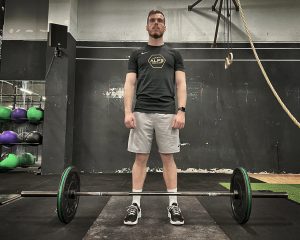 |
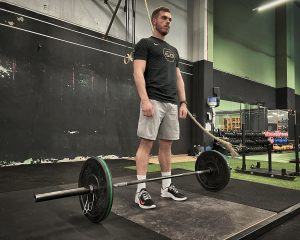 |
| Pic 1 & 1a: in front of the barbell – feet shoulder-width apart on the ground |
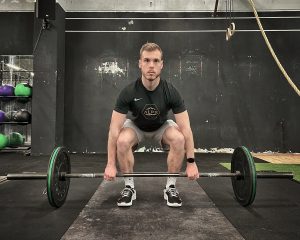 |
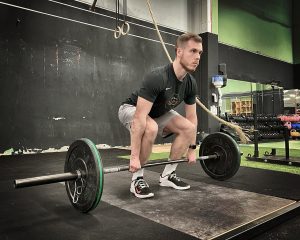 |
| Pic2 & 2a: starting position of lifting |
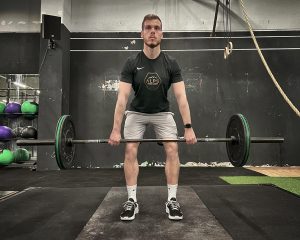 |
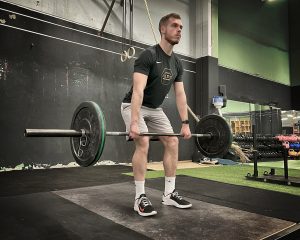 |
| Pic 3 & 3a: mid position – shins verticaly |
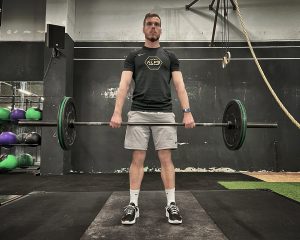 |
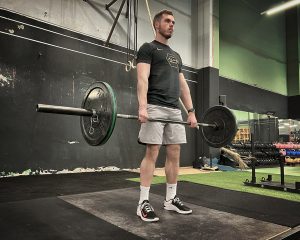 |
| Pic 4 & 4a: end position – fully extended |
Now that the correct execution of the exercise has been described, the question comes up when the deadlift should be performed in a patient setting. Therefore, at first it needs to be classified if the exercise is used to test the correct method of lifting up objects from the ground or as an therapeutic exercise to strengthen the patient.
If it is planned to do this as a test, the "additional tests" (item 7 of the P/E checklist) would be optimal after weighing up all risk-benefit factors.
Even if the deadlift should be used as training and thus as a treatment, the correct implementation must first be tested and, if necessary, worked out.
Which adaptions can be made when treating patients?
One of the most used adaptions, is to start lifting the weight from a higher position. This leads to a reduced load on the lower back. In general, this load in the lower back increases as the weight to be lifted increases. Due to that, it’s important to ensure that the patient has enough strength to maintain muscle tension in the dorsal chain. When the weight is lifted from a higher starting position the upper body has less forward lean which leads to less stress in the lower back. The literature has shown that heavy lifting or performing a one repetition maximum leads to an increased stress on L5/S1. Such high loads are rarely used in a therapeutic setting unless professional athletes are treated. (Yanagisawa et al 2020)
Depending on the performance level of the patient, a strength endurance training with approx. 15 repetitions (3x15 for untrained also 3x10) is offered as a basic training.
The deadlift can also be adapted to the need of the patients in various other ways.
If needed the position of the feet can be changed. The most commonly variant is the sumo deadlift, where the feet are placed much further apart with more external rotation. This is often found to be comfortable for knee patients since the lifting path is reduced due to the wider starting position.
Instead of a barbell, the deadlift can also be performed with a kettlebell, dumbbells, or everyday objects. (Pic 5-7)Thereby the exercise can be adapted to the level of performance and the situation of the patients.
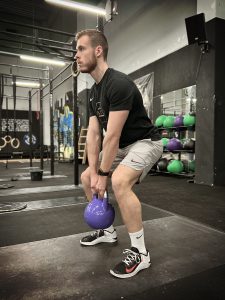 |
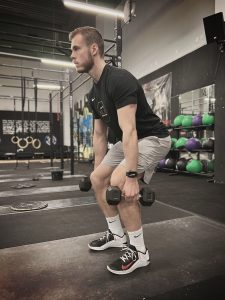 |
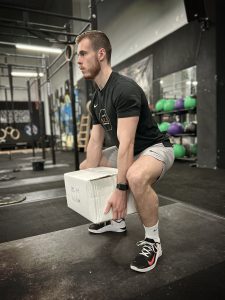 |
| Pic 5: with kettlebell | Pic 6: with dumbbells | Pic 7: with every day objects |
Especially people with low pain intensity and experience in the deadlift can benefit when performing this exercise. The literature describes a pain reduction of more than 30% and an improvement in function in mechanical low back pain as a result of an 8-week training period. (Berglund et al 2015)
Are you already doing deadlifts with your patients?
Share your experiences with us!
#deadlifts #activephysiotherapy #functionaltraining #functionalfitness #backpain #strengthtraining #weighttraining
Further readings
Aasa B, Berglund L, Michaelson P, Aasa U. Individualized low-load motor control exercises and education versus a high-load lifting exercise and education to improve activity, pain intensity, and physical performance in patients with low back pain: a randomized controlled trial. J Orthop Sports Phys Ther. 2015 Feb;45(2):77-85, B1-4.
Berglund L, Aasa B, Hellqvist J, Michaelson P, Aasa U. Which Patients With Low Back Pain Benefit From Deadlift Training? J Strength Cond Res. 2015 Jul;29(7):1803-11
Choe KH, Coburn JW, Costa PB, Pamukoff DN. Hip and Knee Kinetics During a Back Squat and Deadlift. J Strength Cond Res. 2021 May 1;35(5):1364-1371.
Fischer SC, Calley DQ, Hollman JH. Effect of an Exercise Program That Includes Deadlifts on Low Back Pain. J Sport Rehabil. 2021 Feb 24;30(4):672-675.
Martín-Fuentes I, Oliva-Lozano JM, Muyor JM. Electromyographic activity in deadlift exercise and its variants. A systematic review. PLoS One. 2020 Feb 27;15(2):e0229507. doi: 10.1371/journal.pone.0229507.
Neto WK, Soares EG, Vieira TL, Aguiar R, Chola TA, Sampaio VL, Gama EF. Gluteus Maximus Activation during Common Strength and Hypertrophy Exercises: A Systematic Review. J Sports Sci Med. 2020 Feb 24;19(1):195-203.
Yanagisawa O, Oshikawa T, Matsunaga N, Adachi G, Kaneoka K. Acute Physiological Response of Lumbar Intervertebral Discs to High-load Deadlift Exercise. Magn Reson Med Sci. 2021 Sep 1;20(3):290-294.

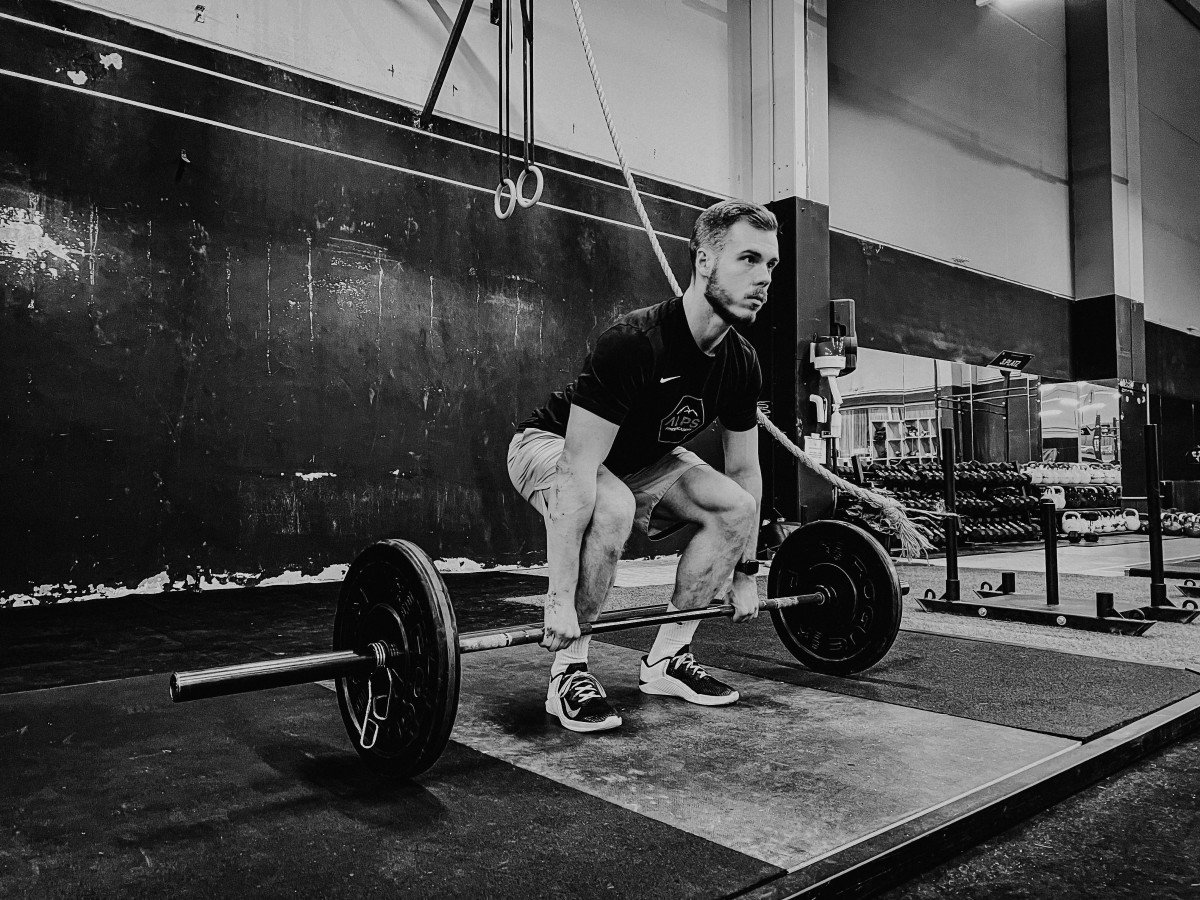



Comments